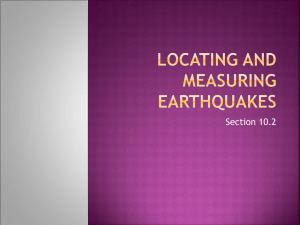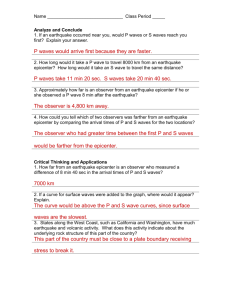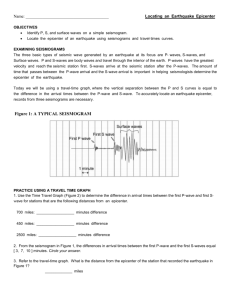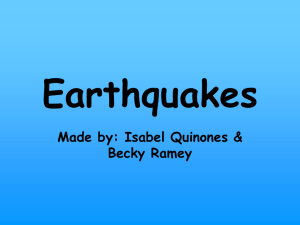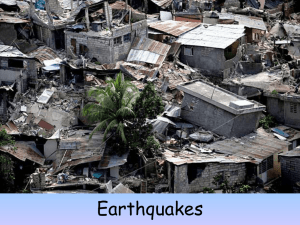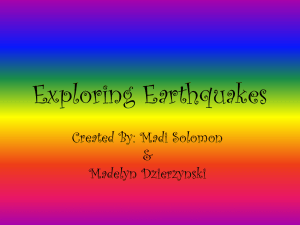Earthquakes
advertisement
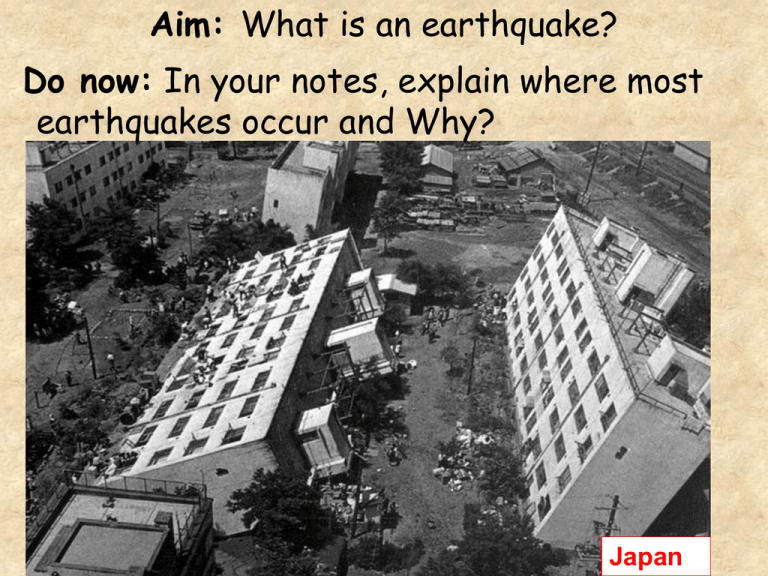
Aim: What is an earthquake? Do now: In your notes, explain where most earthquakes occur and Why? Japan I. Earthquakes - are vibrations in the crust caused by moving crustal plates. California A. Focus - the origin (starting point) of the earthquake underground. B. Epicenter – the location on the surface directly above the focus. II. Causes of Earthquakes • the release of potential energy stored in rock. • energy is released in all directions A. Elastic Rebound Hypothesis - Deformation of rocks (stressing/bending) cause them to build up pressure (energy). - When they break, the stored energy is released which results in the vibrations. Closure: Why would someone think that most earthquakes cause little damage and little loss of life? - Because most occur in areas that are not populated by people or cities. Tokyo, Japan AIM: How are Earthquakes Measured? Do now: If you were asked to measure a recent Earthquake, what information/ observations/data would you try to use? I. Measuring Earthquakes • Seismology – the study of earthquake waves (energy). *Seismos = earthquake • Seismographs – instruments that record earthquake waves (energy). • Seismogram – a graph produced by recording the ground motion on a seismograph. Creation of Seismogram • Richter Scale: Measures the magnitude (strength) of an earthquake from the seismogram. II. Types of Seismic Waves (earthquake waves) epicenter • created at the time the earthquake begins. • help scientists theorize about the inside of Earth and it’s structure. 1. Body Waves - Travel through the Earth’s interior. P- Wave S-Wave -Travels through solids and liquids. - Cannot go through Liquids. - Travel Faster Travel Slower P & S Wave Animation • P-waves (Primary/Compression Waves) - push-pull waves that compress and expand the ground in the direction that the waves travel. • S-Waves (Secondary/Transverse Waves) - move the ground at right angles (up and down)to the direction that they travel. 2. Surface Waves –seismic waves that travel along the Earth’s outer layers (crust). - Follow P and S waves - Most destructive since they are on the surface China 3. Aftershocks and Foreshocks • movements of the crust that follow a major earthquake called aftershocks. • small vibrations called foreshocks come before a major earthquake. Anchorage, Alaska III. Earthquake Zones The “Ring of Fire” is the area that surrounds the Pacific Plate which is marked with volcanoes and earthquakes. Aim: How do we locate Epicenters? Do Now: 1) From the side table obtain the two white worksheet. 2)Describe the causes of earthquakes. Earthquakes are caused by the rapid release of energy stored in rock that has been subjected to great forces (at plate boundaries where plates move). This releases of energy causes the vibrations of an earthquake. I. Locating an Earthquake epicenter • The difference in arrival times of P and S waves helps to locate the epicenter. • The greater the difference, the greater the distance to the earthquakes epicenter. Take a worksheet from the top bin to practice subtracting P and S wave times. II. Distance to Epicenter A) Find the difference in arrival time between the first P wave and the first S wave on the seismogram. S-wave Arrival - P-wave Arrival B) Using ESRT page 11 and a piece of scrap paper, we can find the equivalent distance. **ESRT Page 11 and a piece of scrap paper ** S-wave – P-wave = 00:04:45 1) Use the time axis to mark off this difference in time. Always use 0 to start. 2) Slide the scrap paper up the chart to match the P and S wave lines with the marks you made. 3) Once they are matched, as close as you can, read down from this intersection to find the equivalent distance. “Spread Technique” III. P- Wave Travel Time (or s-wave travel time) -Use the distance from the previous step to find the travel time. - Move up to the wave you are looking for. (either P or S) IV. Origin Time -The origin is when the earthquake began. (start) - Subtract the arrival time from the travel time Origin (start) Travel Time Arrival (end) V. Epicenter Location • Data from three or more seismographs must be used to find the exact location of an earthquake epicenter. Epicenter - Use the distance to epicenter value and a protractor to draw these circles.

